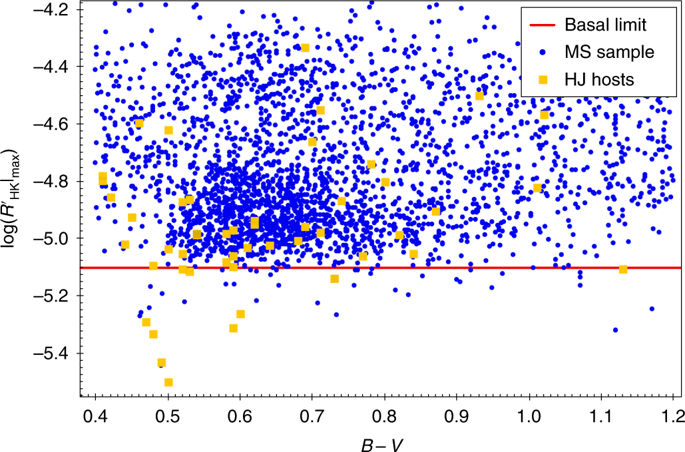Nature Astronomy ( IF 12.9 ) Pub Date : 2019-12-23 , DOI: 10.1038/s41550-019-0973-y Carole A. Haswell , Daniel Staab , John R. Barnes , Guillem Anglada-Escudé , Luca Fossati , James S. Jenkins , Andrew J. Norton , James P. J. Doherty , Joseph Cooper

|
Some highly irradiated close-in exoplanets orbit stars showing anomalously low stellar chromospheric emission. We attribute this deficit to absorption by circumstellar gas replenished by mass loss from ablating planets. Here we report statistics validating this hypothesis. Among ~3,000 nearby, bright, main-sequence stars, ~40 show depressed chromospheric emission indicative of undiscovered mass-losing planets. The Dispersed Matter Planet Project uses high-precision, high-cadence radial velocity (RV) measurements to detect these planets. We summarize results for two planetary systems (DMPP-1 and DMPP-3) and fully present observations revealing an Mp sin i = 0.469 MJ planet in a 5.207 d orbit around the γ Doradus pulsator HD 11231 (DMPP-2). We have detected short-period planets wherever we have made more than 60 RV measurements, demonstrating that we have originated a very efficient method for detecting nearby compact planetary systems. These shrouded, ablating planetary systems may be a short-lived phase related to the Neptunian desert, that is, the dearth of intermediate-mass planets at short orbital periods. The circumstellar gas facilitates compositional analysis, allowing empirical exogeology in the cases of sublimating rocky planets. Dispersed Matter Planet Project discoveries will be important for establishing the empirical mass–radius–composition relationship(s) for low-mass planets.
中文翻译:

分散物质项目计划发现了围绕附近明亮恒星运行的行星的消融过程
一些高度辐射的近系外行星轨道恒星表现出异常低的恒星发色层辐射。我们将此赤字归因于由消融行星引起的质量损失所补充的星际气体吸收。在这里,我们报告的统计数据验证了这一假设。在约3,000个附近明亮的主要序列恒星中,约有40个显示出降低的色球发射,这表明未发现质量损失行星。“分散物质行星项目”使用高精度,高节奏的径向速度(RV)测量来检测这些行星。我们总结了两个行星系统(DMPP-1和DMPP-3)的结果,并充分呈现了观测结果,得出M p sin i = 0.469 M J行星围绕γDoradus波轮HD 11231(DMPP-2)的5.207 d轨道飞行。我们在进行60多次RV测量的任何地方都检测到了短周期行星,这表明我们已经发明了一种非常有效的方法来检测附近的紧凑行星系统。这些笼罩,消融的行星系统可能是与海王星沙漠有关的短暂时期,也就是说,在短轨道周期中缺乏中等质量行星。绕星气体有助于成分分析,在升华岩石行星的情况下可以进行经验外地质学。分散物质行星项目的发现对于建立低质量行星的经验质量-半径-成分关系将是重要的。











































 京公网安备 11010802027423号
京公网安备 11010802027423号